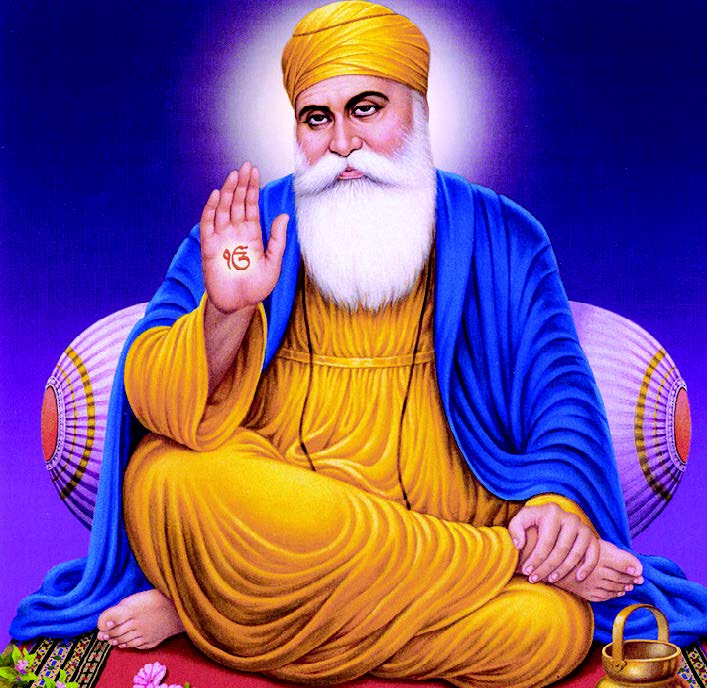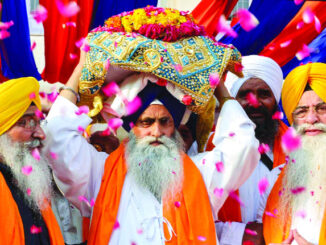
Shri Guru Nanak Dev Ji is the first Master of the Sikhs, a 25 million community which has its origin in Punjab State of India where the most Sikhs live, inhabits almost all parts of the world. The Sikh population in the USA is roughly 500,000. There are another half a million Sikhs in Canada.
Guru Nanak Dev Ji, the founder of Sikhism and the first of the 10 Gurus of the Sikhs, was born in the village of Talwandi. Sri Guru Nanak Dev Ji was born on 15th April 1469. However, Sikhs now celebrate this auspicious event each year on the full moon day in November. Thus the date changes from one year to the next. He was born into a Bedi Kshatriya family in the village of Rai Bhoi di Talwandi. It’s now called Nankana Sahib. These days there is Gurdwara Janam Asthan at this place. Guru Nanak Dev Ji was born to mother Tripta Devi and father Mehta Kalu. Guru Nanak’s father was a patwari working for Rai Bular Bhatti. His full name was Mehta Kalyan Das Bedi. Guru Nanak Dev Ji had one elder sister called Bebe Nanaki. She was the first to recognise Nanak as an enlightened Soul.
Guru Nanak from an early age seemed to have acquired a questioning and enquiring mind. He refused as a child to wear sacred thread called Janeu, saying instead that he would wear the true name of God in his heart for his protection. He reasoned that the thread could be broken, soiled, burnt or lost and could not offer any security at all. At age seven, his father, Kalu Mehta, enrolled him at the village school. As a child Guru Nanak astonished his teacher by describing the implicit symbolism of the first letter of the alphabet. In Persian or Arabic it is a straight stroke, resembling the mathematical version of one. He described it as denoting the unity or oneness of God.
Other childhood sakhis refer to strange and miraculous events about Guru Nanak. In one account Rai Bular witnesses a poisonous cobra shielding the child Nanak’s head from the harsh sunlight. The young Nanak enjoyed the company of holy men and engaged them in long discussions about the nature of God. Nanak married Sulakhni, of Batala, and they had two sons, Sri Chand and Lakhmi Das. His brother-in-law Jai Ram obtained a job for him in Sultanpur as the manager of the government granary. One morning, when he was twenty-eight, he went as usual down to the river to bathe and meditate. It was said that he was gone for three days. His clothes were found on the bank of a local stream called the Kali Bein. The townspeople assumed he had drowned in the river; Daulat Khan had the river dragged, but no body was found. Three days after disappearing, Guru Nanak reappeared, staying silent. The next day, he uttered the words: “There is no Hindu and no Musalman.” This pronouncement was substantial as it referred to the day and age in which Guru Nanak lived: Hindus and Muslims of India constantly and bitterly fought each other over the issue of religion. The Guru meant to emphasize that, ultimately, in the eyes of God, it is not religion that determines a person’s merits, but one’s actions.
Travels
Guru Nanak is widely acknowledged to have made four major journeys, spanning thousands of kilometres. The first tour being east towards Bengal and Assam, the second south towards Tamil Nadu, the third north towards Kashmir, Ladakh, and Tibet, and the final tour west towards Baghdad, Mecca and Medina on the Arabian Peninsula. At Mecca, Guru Nanak was found sleeping with his feet towards the Kaaba mosque. Kazi Rukan-ud-din, who observed this, angrily objected. Guru Nanak replied that it is not possible to turn his feet in a direction that did not have God or a house of God. The Kazi understood that the meaning of what the Guru was saying was “God is everywhere”. The Kazi was struck with wonder.
Personal Life
As a householder, Nanak continued to carry out the mission of his life to lead people on the true path to God, to dispel superstition, to bring people out of ritualistic practises, to lead them directly to follow Gurbani without the need for priests and clergy, and to restrain and guard against the five thieves within –Pride, Anger, Greed, Attachment and Lust. The Guru witnessed the Mughal invasion of India, and saw the horrors inflicted upon the common people by the invaders. Though a pacifist, Guru Nanak did not hesitate to speak up against injustice:
The kings are ravenous beasts, their ministers are dogs.
The Age is a Knife, and the Kings are Butchers.
In this dark night of evil, the moon of righteousness is nowhere visible.
Teachings
Among the many philosophical foundations laid by Guru Nanak, his characterization of God is most recognizable. It forms the opening lines of Guru Granth Sahib. The translation is as follows:
There is but One God, The Supreme Truth; The Ultimate Reality, The Creator, Without fear, Without enemies, Timeless is His image, Without Birth, Self Created, By His grace revealed.
Guru Nanak’s teachings can be found in the Sikh scripture Guru Granth Sahib, as a vast collection of revelatory verses recorded in Gurmukhi. Guru Nanak describes the dangers of the Egotism and calls upon devotees to engage in worship through the word of God. The word of God, cleanses the individual to make such worship possible. Guru Nanak warned against hypocrisy and falsehood saying that these are pervasive in humanity. Through popular tradition, Guru Nanak’s teaching is understood to be practised in three ways:
VAND CHHAKKNA: Sharing with others, helping those with less who are in need
KIRAT KARNA: Earning/making a living honestly, without exploitation or fraud
NAAM JAPNA: Chanting the Holy Name and thus remembering God at all times (ceaseless devotion to God)
Guru Nanak put the greatest emphasis on the worship of the Word of God (Naam Japna). The crux of his teaching was
“Equality of Humans” without distinction of caste or creed. Guru Nanak preached against discrimination and prejudices due to race, caste, status, etc. He didn’t only preached these concepts he also took practical steps to acheive it. He started the institution of langar, where people have to sit together to eat without any distinction.
Guru Nanak believed in equality of men and women. He elevated the position of women by spreading this message: “From woman, man is born; within woman, man is conceived; to woman he is engaged and married. Woman becomes his friend; through woman, the future generations come. When his woman dies, he seeks another woman; to woman he is bound. So why call her bad? From her, kings are born. From woman, woman is born; without woman, there would be no one at all. O Nanak, only the True Lord is without a woman.” Besides rejecting the Hindu caste system, idolatry, and ritualism, Guru Nanak preached universal equality. In consistence with his message of equality, Guru Nanak scorned those who considered women to be evil and inferior to men by asking: Why should we call her inferior, when it is she who gives birth to great persons?
Last years
As the end approached Guru Nanak would frequently test the devotion of his sons and nearest followers and in doing so demonstrate their state of mind to one another. There were numerous such occasions and one particular devotee, Bhai Lehna, rose to eminence because he never faltered in his faith in Guru Nanak. Guru Nanak appointed Bhai Lehna as the successor Guru, renaming him as Guru Angad, meaning “one’s very own” or “part of you”. Shortly after proclaiming Bhai Lehna as the next Guru, Nanak died on 22 September 1539 in Kartarpur, at the age of 69.
Guru Nanak was revered by both Hindus and Muslims. This is crystallised when on his deathbed they both quarreled about whether his body should be cremated as per the Hindu tradition or buried as per Islamic tradition.




Be the first to comment